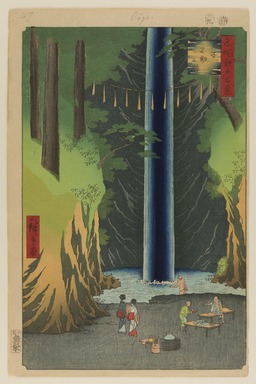
Artist:Utagawa Hiroshige
Medium: Woodblock print
Geograhical Locations:
Dates:9th month of 1857
Dimensions: Sheet: 14 1/4 x 9 5/16 in. (36.2 x 23.7 cm) Image: 13 x 8 1/2 in. (33 x 21.6 cm)
Collections:
Exhibitions:
Accession Number: 30.1478.49
Image: 30.1478.49_PS20.jpg,
Catalogue Description: Summer scene of Fudo Falls in the oji area, one of the better known of the "Seven Falls of Oji," acclaimed for its religious, curative, as well as scenic qualities. Those visiting the falls for the religious reasons approached through the precincts of the Shojuin Temple, founded in the sixteenth century by a holy man who practiced the way of Fudo ("unmovable"), a Buddhist deity, depicted as wreathed in flame and grasping a sword in his right hand. An image of Fudo was placed to the right of the waterfall (not shown in this print). A "shimenawa" rope above sets off the sacred place, which serves to illustrate that Buddhism and Shinto cannot be separated. The curative power of the spring is shown by two men bathing in its waters, which were said to relieve almost any ailment. One man is shown testing the water, while the other reaches for a cup of hot tea from the old woman who makes her living by the falls. Two women dressed for a summer outing admire the scenery, a secluded setting densely shadowed with green trees, with little sunlight and few people. The Fudo Falls survived into the twentieth century. The Takinogawa Middle School was constructed here in the 1950's, although various Fudo images may still be seen on the grounds of the Shojuin Temple.